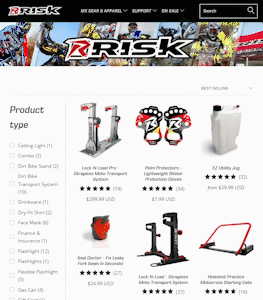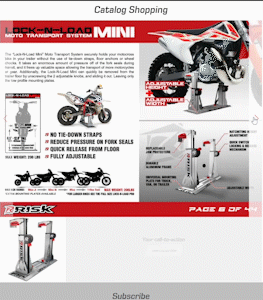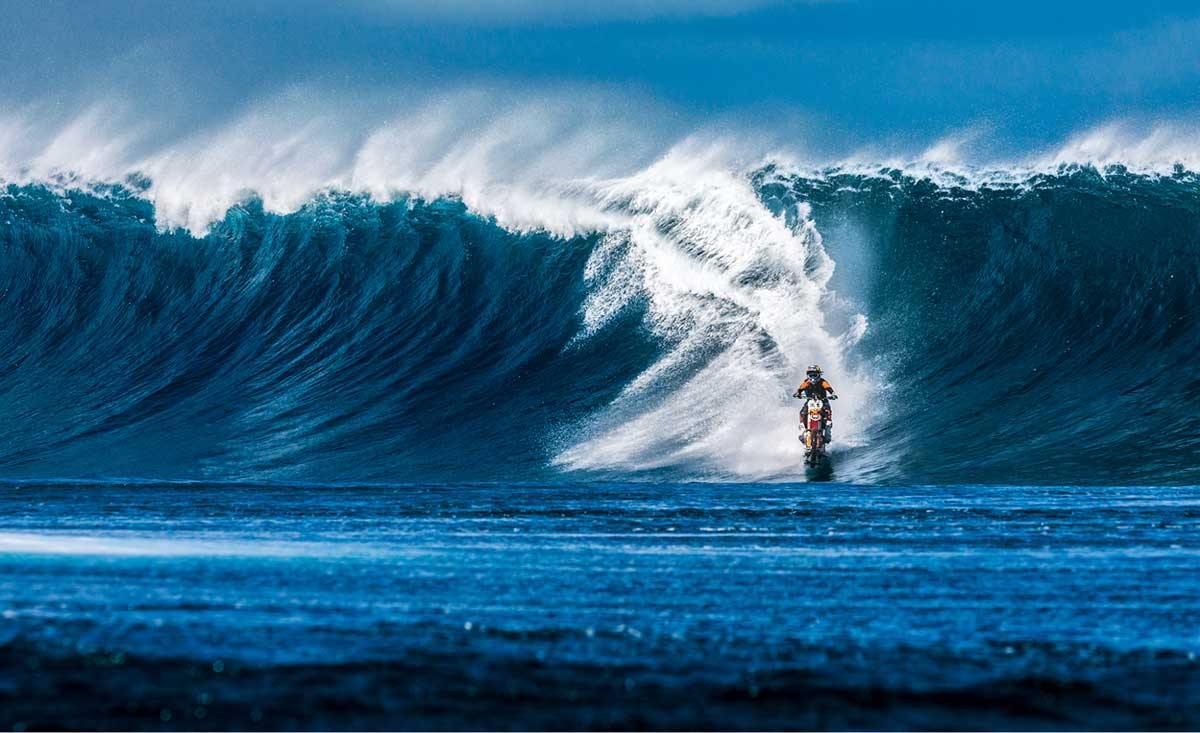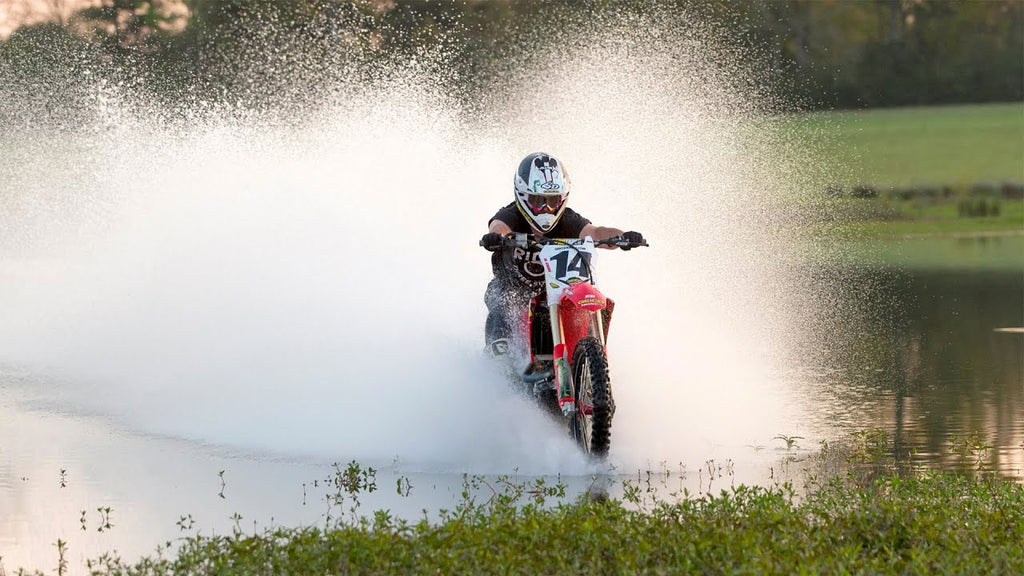Your Cart is Empty
MOTO Products
shop your way
Choose a shopping experience
Same great Risk Racing products, 3 completly different ways to shop them.
Choose a shopping experience
Same great Risk Racing products, 3 completly different ways to shop them.

Lifestyle Shopping

eComm Shopping

Catalog Shopping
MOTO TYRES
MOTO Gear & Apparel
Can a Dirt Bike Ride on Water and What to Do if It Falls In?
May 11, 2021 5 min read

You got your dirt bike to take on great adventures with you. You know all about the excitement of just racing around or doing laps on the track, but you may not know all about riding on water. It may seem like a movie trick and you may be wondering if that’s something you could do.
You can ride on water, as long as you have the right equipment. This is possible by:
Reading on, you can learn all about whether or not your dirt bike can ride on water. You will also learn how to handle it if your bike gets submerged in water.

Can Dirt Bikes Go Through Water?
You can get dirt bikes wet, but this shouldn’t be something that you allow to happen for the long term. You also shouldn’t let your dirt bike go through water that is too high, otherwise, you could run the risk of water entering into the engine.
Stick to water that is not higher than the engine frame of the bike to stay safe. This allows you to get the thrill of riding through while mud and water fly around you, without the risk of any serious damage to your bike.
What to Do If Your Dirt Bike Falls in Water?
Did your bike fall in water? Get the bike back onto dry land as quickly as possible. The longer that the bike remains submerged, the more potential damage can be caused. Then, you will need to go through the process of fixing your drowned bike as soon as you get to dry land.

How Do You Fix a Drowned Dirt Bike?
In general, there are typical steps that you should take if you have a drowned dirt bike. Before anything else, you need to make sure that you get your bike back on land as soon as possible and keep it upright. The steps that you would take include:
- Immediately remove the spark plug, seat, and tank.
- Remove your air filter, then drain the water from the bike’s airbox.
- Turn off the fuel switch.
- Tip your bike backwards, as if you were doing a wheelie, allowing the water to drain from the exhaust pipe. This may require a friend to help, if possible.
- Using your hands, push the bike’s kickstart down between 8 and 10 times in order to pump the water out of the bike’s plug hole. If you don’t have a kickstart on your bike or if the bike is a lightweight two-stroke engine, you could tip the bike upside down and rest it on the handlebars. Then, put your bike in top gear, spinning the back wheel to allow the water to pump out of the plughole.
- Flip the bike back onto its wheels, then remove the drain plug from the bike’s carburetor float bowl. You don’t need to perform this step if you have a fuel-injected bike. After the gasoline drains out, replace the plug.
- Carefully wring out the air filter foam element and try to refit it. If possible, let the spark plug and air filter dry out in the sun for a little bit.
- Dry the spark plug off completely with a dry rag or put a new one on if you have an extra.
- Try starting the bike. If it fires up as normal, you should be fine. Otherwise, you may need to do some work on it.
These are steps to take immediately after the bike drowns. When you get home, there are some other steps to take to ensure the bike recovers fine.
- Change the engine filter and oil
- Clean and/or replace your air filter
- Change your radiator coolant
- If the exhaust packing had lots of water enter it, replace it.

Can a Motorcycle Ride on Water?
It does take some practice and special equipment, but it is possible that your motorcycle can ride on water. The thing that you need to remember is that if your bike gets submerged, that can be a major problem.
There are a few ways that this is possible. One approach is through “surfing BMX”, where the bike has skis that go around the front and rear tires. This helps to keep the bike buoyant, but it can take some practice to get the skis on right and making sure that they stay on.
Then there is aquaplaning, which is something that can be done on shallow pools of water. This happens when the front tire creates a wedge of water underneath the leading edge, causing the tire to lift up and glide along the water.
Before anything else, you should know that two-stroke engines tend to be better for this task than four-stroke engines. One of the biggest reasons for this is because it’s harder to save a four-stroke engine if the bike becomes submerged.
There is a process that needs to happen to be successful in riding on water.

Starting Out on Land
It’s really important that you go through the process and start out on land. But starting out on the shore isn’t good enough. You need to start out some distance away from the shore, building up speed and momentum so that you can ride along the water for a period of time. Ideally, you want to get to around 60 MPH on land before you make it to the water. Though, this might not be fast enough.
Maintain the Speed
While getting started on land and building up speed is an important part of the process, it’s also very important to maintain the speed once you hit the water. This can be somewhat difficult as the bike will naturally slow down when you leave dry land. On the water, most experts say that they can only really maintain speeds of between 30 and 35MPH. This also requires you to have a smooth transition from the land into the water. There shouldn’t be any bumps into the water.

Not for Beginners
Anytime that you see videos of people who succeed at riding on the water, these are usually professional riders that have mastered the craft on the track as well as riding on water. In many cases, they even have bikes that have been custom-made specifically for this purpose. If you are an experienced rider that wants to move onto the next challenge, this can be a cool place to start. Otherwise, you should wait until you get some more experience under your belt before attempting this.
Special Equipment
As previously mentioned, you will need special equipment to accomplish riding on water. Water skis are one of the most important pieces of equipment that you will need. Whether they are attached to the tires or the hubs of the tires, these are essential to have. You should consider the materials before you purchase skis, as plastic is typically the better choice for this purpose. You should also get modified tires. There are tires that can be modified to have rubber blades on them, similar to propellers that help boats move.
Conclusion
Riding your bike in extreme conditions can make riding even more thrilling. However, things can go wrong especially when trying to ride on water or ride through water. Fortunately, there are things that you can do that can help you save your bike from severe damage.
Leave a comment
Comments will be approved before showing up.
Subscribe
Sign up to get the latest on sales, new releases and more …

Limited Time 10% Off
Save on your 1st order and get email offers when you join.
Eligible for first-time website purchases only. Emails may take a few minutes to process and could get flagged by email providers as junk so be sure to wait a little bit and check your junk and/or spam folders.

 UK/EU▾
UK/EU▾


























